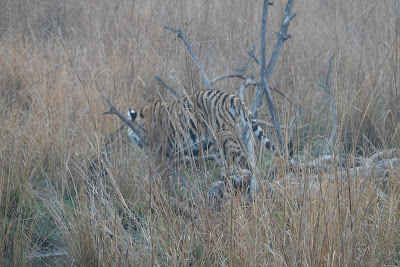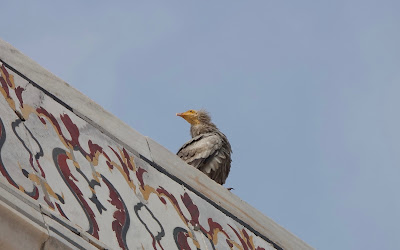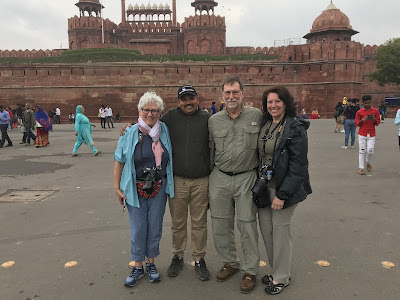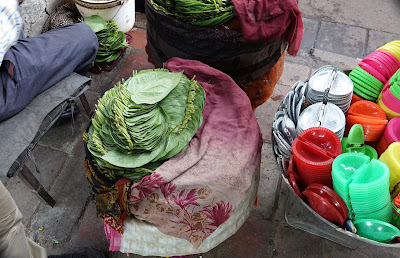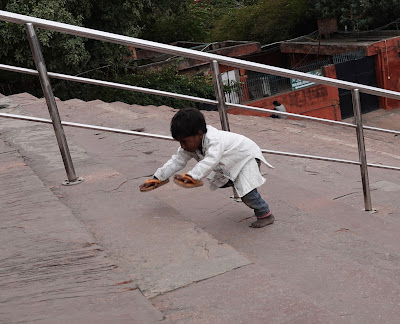As I write my India blog, I've been keeping a close eye on Matt Hysell's 2020 Ecuador trip blog on Birding Berrien and Beyond. Just as I was leaving for India I saw his February 17th entry, Down the Shiripuno river and I was a little envious. Typically, I would have been on this trip, having gone with Matt's group the past 6 years to Central and South America. I love Matt's trips because they are typically pretty adventurous and energetic, (ex: the past couple of year's we been freezing at 15,000 feet in Ecuador), and this year seems to have been no different. Matt's blog can be pretty spare on narrative, but Ecuador 2020 is more descriptive, probably because of the experiences they had. I definitely recommend following Matt's trip blog.
But in a roundabout sort of way this India trip called to me and I had to switch course for this year. However, in most ways, my trip was not energetic or even particularly adventurous. Riding around Ranthambore in a 4 person jeep is not particularly energetic unless I count absorbing the bumpy trail roads and keeping my camera safe as energy-consuming. Each day was like being able to bird all of Point Mouillee in an open car. Sweet birding, but not high-level physical activity.
I digress. Back to tigers. We left the hotel in the dark and entered the park just at dawn. Again, within a very short time, another tiger. This time we were one of the first jeeps to arrive and, although the tiger was obscured by grass, we had plumb viewing.
It had become crowded with other tiger viewers and, between the prior day's great viewing and this morning, we felt like we could leave and let others in for closer views.
But in a roundabout sort of way this India trip called to me and I had to switch course for this year. However, in most ways, my trip was not energetic or even particularly adventurous. Riding around Ranthambore in a 4 person jeep is not particularly energetic unless I count absorbing the bumpy trail roads and keeping my camera safe as energy-consuming. Each day was like being able to bird all of Point Mouillee in an open car. Sweet birding, but not high-level physical activity.
I digress. Back to tigers. We left the hotel in the dark and entered the park just at dawn. Again, within a very short time, another tiger. This time we were one of the first jeeps to arrive and, although the tiger was obscured by grass, we had plumb viewing.
Another young tiger. After drinking, it jumped across the water and began to walk through the grass.
Two tigers! We were told they were siblings.
Playful sparring
Slowly walking away.
It had become crowded with other tiger viewers and, between the prior day's great viewing and this morning, we felt like we could leave and let others in for closer views.
After driving around and finding birds and other things our guide, Jyoti, got bored and wanted to go back for more tiger viewing. We were glad he did because this time we came upon the family of three; mother and the two siblings. They were most often not very visible, but we could hear their growls at they sparred in the bushes. There was a thought that there was a kill hidden in the bush and that they were taking turns eating.
It was after this second viewing that we began to hypothesize about Jyoti, who seemed to be one of the park's senior guides. More about this later if I can work it into the narrative.
One might think that tiger viewing, as we experienced it, is easy at Ranthambore. At this point, we thought it was. However, we later learned that we were very lucky. Many other visitors did not see tigers. If you had only a couple of safaris scheduled, your chances might be slim. We learned that, Bob, our trip planner and our guide, Ansar, had scheduled six safaris to enhance our chances and because Ansar knew it was possible not to see any tigers at all. Since there is a lot to see at Ranthambore the six safaris was always well-spent, with or without seeing tigers. For our remaining safaris we always looked for tigers but never again saw them. We had been lucky.
Finally, it is possible also to see leopards at Ranthambore, but much more difficult. I and a few of us did, fleetingly, see a leopard (some even got a couple of photos) at the end of one afternoon safari. It was thought that the leopard had came into the open to collect a dead langur that had been killed in recent territorial fight. We missed the fight, but saw the dead langur lying at the edge of the road. Later when we returned along this same route, the dead langur was gone. It was shortly after that we saw the leopard very near this same area.
This ends post #5. Next post: Ranthambhore birds





